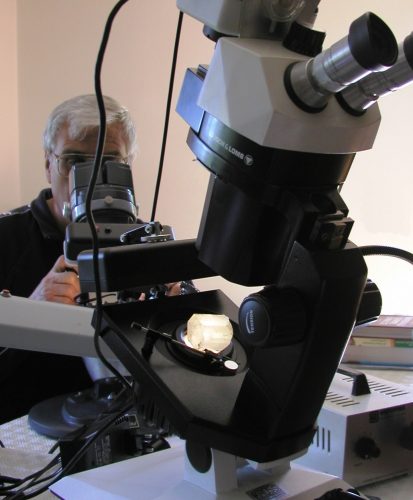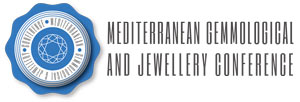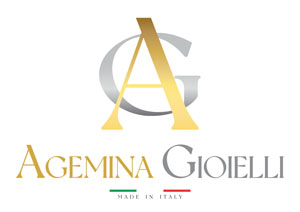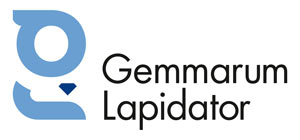 My dear friends (both near and far), whether the microscope proves to be fully yours or you were merely entrusted with such an instrument just for the week-long course or to carry out the assigned jobs, this makes no great difference: what has uncle Luigi always told you? Those who do not look after the microscope as if it was their own baby – or better – the apple of their eyes – deserve to have their own hands cut off. Do you remember? Never remove the oculars from their seat so as to prevent dust, atmospheric dust, various circulating residues from infiltrating in the optical system. Run away from smoke contaminations of the lenses in the optical system as you would do before the devil: in the long run the film of smoke, cigarette smoke, yes I said cigarette, that inevitably deposits on lenses can lead to blurring and corrosion. Always check the focusing – adjusting it to your sight – both when it passes from analyst to analyst, from a day to another, as well as in different and spaced times of the same day (just in case someone passing by put an eye on it, and his hands too, adjusting the instrument to his own sight). In such an event, after working for half an hour with a sight that has not been adjusted, you are likely to suffer from a kind of nausea, in the best of cases, or a nice migraine in the worst, thus paying the price for your carelessness. Does this make you laugh? Try and then tell me.
My dear friends (both near and far), whether the microscope proves to be fully yours or you were merely entrusted with such an instrument just for the week-long course or to carry out the assigned jobs, this makes no great difference: what has uncle Luigi always told you? Those who do not look after the microscope as if it was their own baby – or better – the apple of their eyes – deserve to have their own hands cut off. Do you remember? Never remove the oculars from their seat so as to prevent dust, atmospheric dust, various circulating residues from infiltrating in the optical system. Run away from smoke contaminations of the lenses in the optical system as you would do before the devil: in the long run the film of smoke, cigarette smoke, yes I said cigarette, that inevitably deposits on lenses can lead to blurring and corrosion. Always check the focusing – adjusting it to your sight – both when it passes from analyst to analyst, from a day to another, as well as in different and spaced times of the same day (just in case someone passing by put an eye on it, and his hands too, adjusting the instrument to his own sight). In such an event, after working for half an hour with a sight that has not been adjusted, you are likely to suffer from a kind of nausea, in the best of cases, or a nice migraine in the worst, thus paying the price for your carelessness. Does this make you laugh? Try and then tell me.
Never forget that your fully or temporarily owned microscope is the extension of your eye, that very same eye that searches the recesses of the analysed gem, particularly if it is a coloured gem and if the aim is that of telling the natural item from the synthetic one. In such a case there is no excuse whatsoever: without a microscope you can whistle for it. This because, in most cases, the answers to your questions are to be found in the peculiar inclusions of either the synthetic or the natural material (provided that there are at least two inclusions that are typical of the one or the other material; beware of the single inclusion as, sometimes, it turns out to be a coward traitor). Leaving emeralds aside, which in various occasions offer a way out either thanks to densities or refraction indexes that differ in a type or in the other, in its various versions, if you happened to stumble upon a ruby, a sapphire or other stones, where there is no difference in such identification parameters, you would find yourself in dire straits unless you are as thick as thieves with “it”. What can we say, then, if what you see is not well focused? Worse than ever.
However, one thing must be well cleared: while the refractometer displays accurate reading values and the polariscope offers some well defined reactions that you will have the chance to interpret for diagnostic purposes, the ineffable “two-eyed” instrument does not give you anything. You are left with the task of interpreting what “it” allows you to see, given the magnifications and the resolution (blessed and praised every moment be the most holy and divine instrument). The moral is: you can not get away with it without -almost- knowing in the biblical sense your female friends, the inclusions. And here uncle Luigi, along with other uncles, resolved to rescue you starting a proper dedicated column on the web platform that is being set up for the newly created Associazione IGI – International Gemological Institute – Italy. Without establishing a certain intimacy with the inclusions, “it” remains as mute as a fish. However, once weaned, good heavens what a host of things our dear instrument will tell you!
You will spend hours on it, this I confirm myself after having thousand of stones passed under those lenses. I can not tell the sheer bliss that certain kaleidoscopic views of inclusions offer: you can indulge in interpretative descriptions, more than an art critic in a picture gallery. With quartzes and aquamarines, then, you will fall prey of a tremendous lust. I will never be able to forget the time when, with uncle Alberto (Scarani), we had fun for nearly an hour chasing, in an aquamarine, the gaseous bubble of a two-phase”level” inclusion that, due to the heat of the bright pit, was rolling back and forth to disappear like Fantomas. Switching the microscope off, it reappeared after ten minutes. We lied in waiting until we not only managed to take a picture, but also to film the dance and the “elopement”. How terribly cool! Ah, I forgot: once established a correspondence of amorous senses with your microscope (and above all with your female friends, the inclusions) you could also start the identification process from there, so typical of a gem some inclusions are, to then confirm with the polariscope, the refractometer and the hydrostatic scale. However, not before establishing a certain intimacy and fellowship! And with these recommendations, let me give you my fatherly blessing, Forever Yours, Uncle Luigi.
By Luigi Costantini, published on Rivista Italiana di Gemmologia #1, May 2017.
















